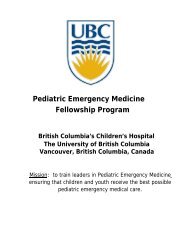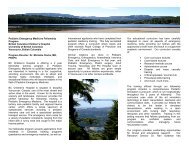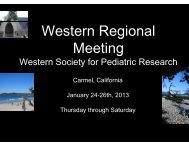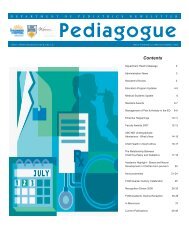UBC Department of Pediatrics Year 3 Student Orientation Manual
UBC Department of Pediatrics Year 3 Student Orientation Manual
UBC Department of Pediatrics Year 3 Student Orientation Manual
You also want an ePaper? Increase the reach of your titles
YUMPU automatically turns print PDFs into web optimized ePapers that Google loves.
Physical Examination (Template – guide)<br />
The approach to the physical examination will vary with the age <strong>of</strong> the child. There are special<br />
manoeuvres that are done at each age.<br />
General: Describe the state <strong>of</strong> alertness, mood and willingness to cooperate with the exam and whether the<br />
child is in distress. Common observations to make are is this child well or unwell, toxic or not toxic.<br />
Vital Signs: HR: RR: Temp: BP: O2 sats:<br />
Height % Weight % OFC %<br />
BMI<br />
Hydration: Are there tears? Comment on mucous membranes and skin turgor.<br />
Head: For infants and children feel for the fontanelle; comment on the shape <strong>of</strong> the head<br />
Eyes: Note presence <strong>of</strong> the red reflex in all children; check papillary reaction, lids/conjunctiva<br />
NB: Fundoscopic exam is difficulty to perform infants but can usually be done in children over 5‐6 years <strong>of</strong><br />
age; (The examination in this age group provides an excellent opportunity to see the optic disc and vessels).<br />
Ears: Check for tenderness <strong>of</strong> pinna, discharge and gross assessment <strong>of</strong> hearing. Check TMs bilaterally.<br />
Nose: Check for discharge, turbinate color<br />
Throat: Check for teeth/caries. Inspect the tongue, buccal mucosal and the posterior pharynx for<br />
erythema, enlarged tonsils. Feel for submucous cleft palate in an infant.<br />
Neck: Gently palpate neck for masses and assess range <strong>of</strong> motion (<strong>of</strong>ten by observation)<br />
Lymphatic: Check LN in neck, axilla and groin.<br />
Chest: Observe for signs <strong>of</strong> respiratory distress (nasal flaring, retractions and grunting). Normal<br />
respiratory rate varies with age; percuss for dullness and then auscultate anterior and posterior lung<br />
fields (remember the RML) Note the inspiratory: expiratory ratio (I: E ratio). Listen for wheezes and<br />
crackles.<br />
Cardiovascular: Observe for cyanosis, respiratory distress and hyperdynamic precordium. Palpate the<br />
precordium (for thrills); auscultate as in adults‐‐‐pediatric heart rates are faster than adults thus<br />
distinguishing systole and diastole is more difficult. Many children will have benign murmurs (<strong>of</strong> no medical<br />
importance) ‐‐‐train your ears to hear them! Palpate the peripheral pulses as in adults. (Femoral pulses are<br />
particularly important to feel in neonates when screening for coarctation <strong>of</strong> the aorta).









